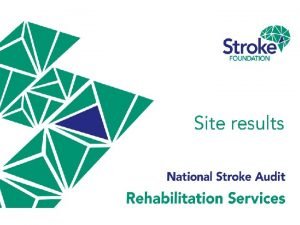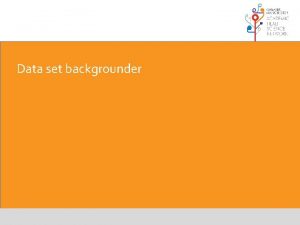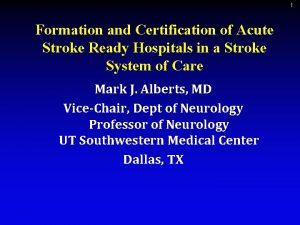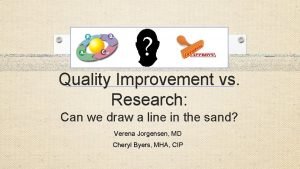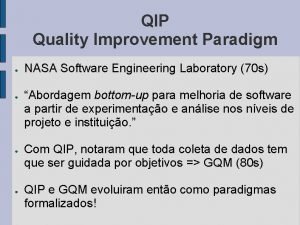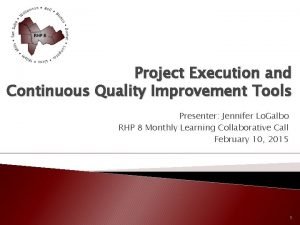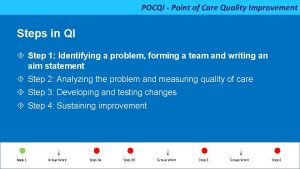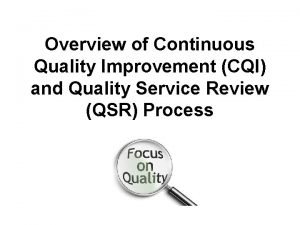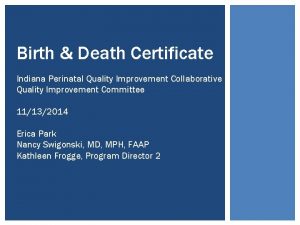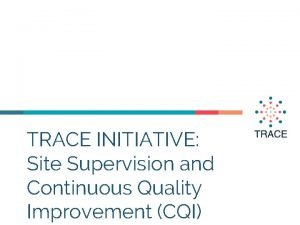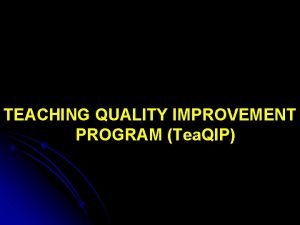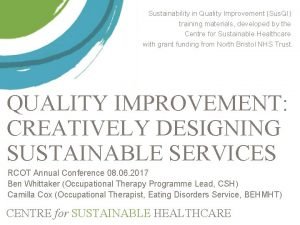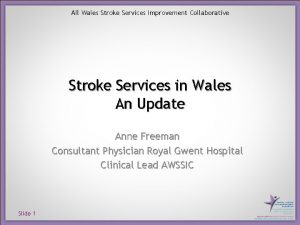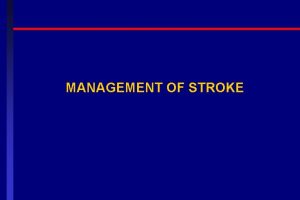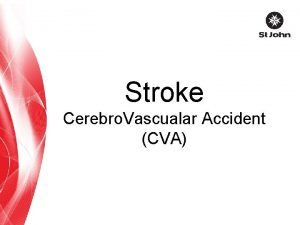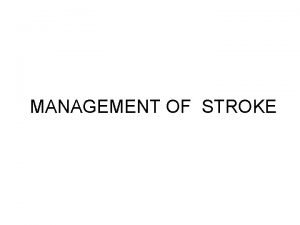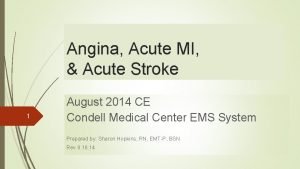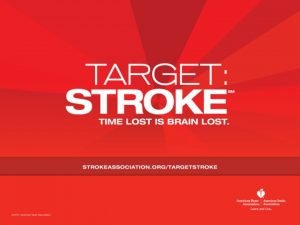National Stroke Audit Acute Services 2019 Quality Improvement










![Organisational Survey Framework [Name] Hospital State [0 sites] n (%) National [120 sites] n Organisational Survey Framework [Name] Hospital State [0 sites] n (%) National [120 sites] n](https://slidetodoc.com/presentation_image/391f05feedd03638009d667c03c32ed8/image-11.jpg)







- Slides: 18


National Stroke Audit Acute Services 2019 Quality Improvement Action Planning • Share with other team members data on both the processes of care and organisational issues that impact on stroke service delivery at your service. • Benchmark the quality of stroke care in your hospital against other hospitals that manage similar numbers of stroke admissions. • Identify potential strengths and weaknesses in the management of stroke and highlight focus areas for ongoing quality improvement activities: 1. Identify issues 2. Define the standard/criteria 3. Review data analysis 4. Implement change 5. Re-audit (through our new spot audit program you can choose a clinical module and audit anytime)

National Stroke Audit Acute Services 2019 Setting up the slide-deck with your hospital’s data • This slide-deck can be tailored and used to share and present your site’s National Stroke Audit data to your team and other stakeholders. • The template is intended to be interactive, please add or remove slides to suit your hospital’s individual requirements. • To populate, refer to your hospital’s site report (in excel format) to locate your Framework and Clinical Care Indicator results. Transpose your results (and state results when required) into each slide. • It is recommended all data is read in conjunction with the National Report which is available to download from https: //informme. org. au/stroke-data/Acute-audits

Where to find your Organisational Survey data. . Step 1. Download your site report: informme. org. au/stroke-data Step 2. Select Tab A. along the bottom of your screen Your site’s results are in column B Find aggregated data for service’s of a similar size to yours in column E

Where to find your Clinical Audit data. . Step 1. Download your site report: informme. org. au/stroke-data Step 2. Select Tab B. along the bottom of your screen Your site’s results are in column B Find aggregated data for service’s of a similar size to yours in column J

National Stroke Audit Acute Services 2019 (Name) Hospital Results National Stroke Audit – Acute Services 2019

The National Stroke Audit - Acute Services comprises two elements: Organisational Survey of acute stroke services across Australia. Retrospective Clinical Audit of inpatient acute stroke case notes. • Examining the resources, processes and infrastructure in place to support best practice stroke care • Examines processes of care as outlined and recommended in the Clinical Guidelines for Stroke Management 2017 • Enables reporting against each required element outlined in the National Acute Stroke Services Framework 2019 • Hospitals reviewed case notes for up to 40 consecutive episodes admitted and discharged between 1 June and 31 December 2018

National Stroke Audit Acute Services 2019 Organisational Survey Assessing the resources required to deliver evidence-based stroke care against the recommendations from the National Acute Stroke Services Framework 2019.

Adherence to the Framework Median number of elements met 1. 2. Plot your hospital’s results below by positioning the dotted line along the X-axis. Insert your states data by right clicking once on the bar graph -> click on edit data in excel -> enter your states median number. My Hospital 15 Australia (N=120) State (N=0) 10 18 500+ stroke patients per annum (N=24) 350 -499 stroke patients per annum (N=11) 200 -349 stroke patients per annum (N=28) 75 -199 stroke patients per annum (N=32) <75 patients per annum (N=25) 16 16 15 11

Organisational Survey Framework 1. 2. Insert your hospital’s name and results in the orange column below. Insert your states data in the green column and similar size services in the last column below. Framework Element of Service [Name] Hospital State [0 sites] n (%) National [120 sites] n (%) Similar size services n (%) Received pre-notification and prepare to rapidly accept potential stroke patient from pre-hospital services No 0 (00%) 89 (74%) 2 (00%) Coordinated emergency department systems (includes use of validated screening tools; agreed triage categories; rapid imaging; rapid referral and involvement of stroke team; protocols for IV thrombolysis and ECR intervention/transfer) No 0 (00%) 88 (73%) 2 (00%) Stroke unit No 0 (00%) 91 (76%) 2 (00%) Rapid access to onsite CT brain (24/7) including CT perfusion and aortic arch to cerebral vertex angiography No 0 (00%) 81 (68%) 2 (00%) Delivery of thrombolysis No 0 (00%) 98 (82%) 2 (00%) On-site endovascular stroke therapy (24/7) No 0 (00%) 13 (11%) 2 (00%) On-site neurosurgical services (e. g. for hemicraniectomy due to large middle cerebral artery infarcts) No 0 (00%) 33 (28%) 2 (00%) Ability to provide acute monitoring (telemetry and other physiological monitoring) for 72 hours No 0 (00%) 115 (96%) 2 (00%) Acute stroke team Yes (00%) 110 (92%) 2 (00%)
![Organisational Survey Framework Name Hospital State 0 sites n National 120 sites n Organisational Survey Framework [Name] Hospital State [0 sites] n (%) National [120 sites] n](https://slidetodoc.com/presentation_image/391f05feedd03638009d667c03c32ed8/image-11.jpg)
Organisational Survey Framework [Name] Hospital State [0 sites] n (%) National [120 sites] n (%) Similar size services n (%) Dedicated stroke coordinator position No 0 (00%) 80 (67%) 2 (00%) Dedicated medical lead No 0 (00%) 89 (74%) 2 (00%) Access to HDU / ICU (for complex patients) No 0 (00%) 112 (93%) 2 (00%) Rapid (within 48 hours) Transient Ischaemic Attack (TIA) assessment clinics/services (including early access to carotid and advanced brain imaging) No 0 (00%) 56 (47%) 2 (00%) Use of telehealth services for acute assessment and treatment No 0 (00%) 86 (72%) 2 (00%) No 0 (00%) 99 (83%) 2 (00%) No 0 (00%) 112 (93%) 2 (00%) Routine involvement of patients and carers in the rehabilitation process No 0 (00%) 120 (100%) 2 (00%) Routine use of guidelines, care plans and protocols No 0 (00%) 70 (58%) 2 (00%) Regular data collection and stroke specific quality improvement activities No 0 (00%) 109 (91%) 2 (00%) Access and collaboration with other specialist services (cardiology, palliative care, vascular) No 0 (00%) 82 (68%) 2 (00%) Framework Element of Service Standardised processes that ensure ALL stroke patients are assessed for rehabilitation. This includes use of standardised tools to determine individual rehabilitation needs and goals (ideally within 48 hours of admission) Coordination with rehabilitation service providers (this should include a standardised process, and/or a person, used to assess suitability for further rehabilitation)

National Stroke Audit Acute Services 2019 Clinical Audit Measuring delivery of care as outlined in the Clinical Guidelines for Stroke Management 2017

Clinical Audit Indicators 1. 2. Insert your hospital’s name and results in the orange column below. Insert your states data in the green column below. Acute Stroke Clinical Care Standard Indicator [Name] Hospital State National % or median National Benchmark Patient transported to a hospital able to provide thrombolysis 0% 00% 76% 94% Validated stroke screen in the emergency department 0% 00% 52% 90% Thrombolysis in ischaemic stroke 0% 00% 10% 27% Thrombolysis in ischaemic stroke for those who arrive within 4. 5 hours of symptom onset 0% 00% 26% 56% Thrombolysis in ischaemic stroke within 60 mins of hospital arrival 0% 00% 32% 70% Median time from onset to thrombolysis 0: 00 2: 45 - Received stroke unit care (all patients) 0% 00% 67% 96% 90% of acute hospital care on a stroke unit (all patients) 0% 00% 41% 75% Assessment for rehabilitation by a physiotherapist within 24 -48 hours of hospital admission 0% 00% 73% 87%

Clinical Audit Indicators 1. 2. Insert your hospital’s name and results in the orange column below. Insert your states data in the green column below. Acute Stroke Clinical Care Standard Indicator [Name] Hospital State National % or median National Benchmark Rehabilitation therapy within 48 hrs of initial assessment 0% 00% 86% 97% Treatment for a rehabilitation goal commencing during an acute hospital admission 0% 00% 92% 97% Carer received relevant training 0% 00% 61% 88% Carer received support needs assessment 0% 00% 63% 89% Patient received education about behaviour change for modifiable risk factors before leaving the hospital 0% 00% 72% 95% Antihypertensive on discharge (haemorrhagic stroke) 0% 00% 72% 77% Discharge on statin, antihypertensive and antithrombotic medications (ischaemic stroke) 0% 00% 69% 88% Discharge on oral anticoagulants for atrial fibrillation (ischaemic stroke) 0% 00% 74% 89% Care plan developed with team and patient (or family alone if patient has severe aphasia or cognitive impairments) 0% 00% 69% 97%

National Stroke Audit Acute Services 2019 National Recommendations Improve stroke unit access Ensure all patients receive lifestyle advice & medication on discharge Increase access to reperfusion therapy Improve access to rapid and advanced brain imaging Stroke coordinators and medical leads recommended for all dedicated stroke services Greater emphasis on Carer support & training Improve TIA services to reduce risk of future strokes

National Stroke Audit Acute Services 2019 Discussion & Quality Improvement Action Plan Key Points: (this slide is for the site presenter to edit) • Develop a QI action plan: 1. Identify gaps (recommend picking your top three topics for focused QI activity over next 6 -12 months) 2. Identify barriers and enablers (for each topic) 3. Documenting a plan - Be specific as to who, will do what, by when 4. Put plan into action 5. Re-audit or sustain/embed improvements • Use SMART goals (Specific, Measurable, Achievable, Realistic, and Timely) • Set up a regular meeting time to review and progress improvements For examples, and step by step guides visit https: //informme. org. au/Improving. Care and click on “Create a QI plan”

National Stroke Audit Acute Services 2019 The Stroke Foundation Inform. Me website brings together a range of resources to support health professionals in delivering the best quality stroke care. On Inform. Me hospital staff can easily access: • Interactive graphs plotting your hospital’s audit data against national, state and peer hospitals (similar sized service) averages. • Your site-specific report and dashboard from current and previous National Stroke Audits. • Support to create your own quality improvement plans in response to your audit results, plus the opportunity to view quality improvement plans that other hospitals have submitted, https: //informme. org. au/Improving-Care Register now: https: //informme. org. au/sign-up

National Stroke Audit 2016 Where to find out more Download the report at: informme. org. au/stroke-data
 National stroke audit rehabilitation services
National stroke audit rehabilitation services Stroke sentinel national audit programme
Stroke sentinel national audit programme Define quality assurance in nursing
Define quality assurance in nursing Compliance vs quality
Compliance vs quality Anterior stroke vs posterior stroke
Anterior stroke vs posterior stroke Acute ischemic stroke algorithm
Acute ischemic stroke algorithm Acute stroke ready certification
Acute stroke ready certification Quality improvement vs research
Quality improvement vs research Qsen quality improvement examples
Qsen quality improvement examples Quality improvement paradigm
Quality improvement paradigm Continuous quality improvement plan example
Continuous quality improvement plan example Point of care quality improvement
Point of care quality improvement Define continuous quality improvement
Define continuous quality improvement Efmd quality improvement system
Efmd quality improvement system Indiana perinatal quality improvement collaborative
Indiana perinatal quality improvement collaborative Cqi action plan template
Cqi action plan template Tea quality improvement
Tea quality improvement Quality improvement
Quality improvement Sustainability in quality improvement
Sustainability in quality improvement
